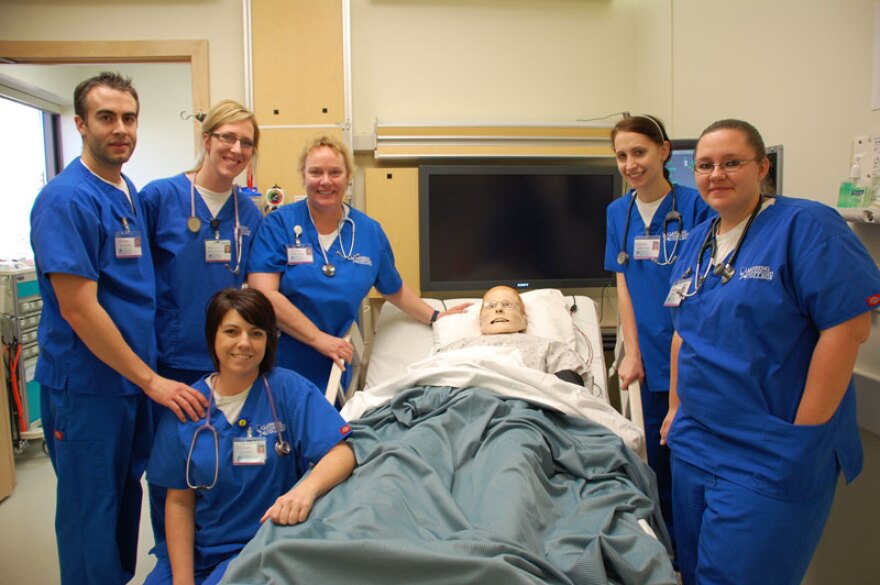The country is facing a nursing shortage, but schools in our region can’t keep up with the demand for nursing education.
As we reported in our first story, that’s partly because there are a limited number of clinical settings where student nurses can work with patients.
http://stream.publicbroadcasting.net/production/mp3/michigan/local-michigan-955617.mp3
Now, to augment the clinical experience, some nursing programs are enlisting the help of a newfangled dummy, wired with smart technology.
Actually, calling these high tech mannequins “dummies” might be a bit insulting.
Forget those passive plastic torsos you’ve seen in CPR demonstrations. We’re talking about high fidelity mannequins, remotely operated by IT guys with headsets and laptops.
Larissa Miller runs the nursing simulation program at Lansing Community College. She can wax poetic about the virtues of the school’s simulated man.
“Our mannequin can shake,” she said, “which is great, we make him have a seizure right in the bed. He can sweat and it starts pouring down his face. He blinks, he breathes, he has pulses…”
He talks. And his female counterpart can even give birth. Miller has been a nurse for 19 years and she says the technology is exploding, "simulation is absolutely one of the fastest paced things I’ve ever watched in education," she said.
It’s estimated there are more than a thousand places across the country that use medical simulation of some kind – including schools and hospitals in Lansing, Cleveland and Chicago.
Miller says that, just like pilots learning to fly, student nurses should do some of their high stakes training in a place where no one can get hurt.
In fact, proponents of simulation training in nursing often point to its success in aviation and the military.
To see simulation in action, I joined Larissa Miller in a dimly lit control room.
We hovered behind a two-way mirror like a couple of cops. But instead of a lineup, we observed a fake patient, in a fake hospital room, surrounded by real students.
They knew that Mr. Pointer, aka the mannequin, was recovering from abdominal surgery. His only complaint was a mild headache.
But Larissa Miller had more in store for the students – and their patient.
“He’s actually going to have a massive … stroke right before their eyes,” she said.
A stroke, caused by a clot that travels to the patient’s brain. The clues were all there – in Mr. Pointer’s heart rhythm, his rising blood pressure, and his worsening headache.
The scenario was videotaped with a timestamp.
When the students debrief with their instructor, they’ll see exactly how long it took them to perform crucial tasks.
So, did they call for help in time?
We’ll find out in a minute.
But first, can a mannequin really take the place of a live patient?
Margie Clark is the Dean of Health and Human Services at Lansing Community College.
She says no.
“The value of going into a facility and working with patients is priceless,” she said. “It would never replace it. But it is a key component for the experience of our students when they get into the clinical, that they can make every minute count.”
That’s because student nurses are often intimidated when they start clinical rotations.
Clark says that simulation builds confidence, which helps students hit the ground running. She adds that gains in efficiency could eventually pave the way for shorter rotations, creating room for more nursing students.
Lansing Community College serves students in the state capital, but simulation also holds promise for students at small rural hospitals who might not get to see a live birth or observe children in acute care without traveling for hours.
The technology is expensive. LCC has several mannequins. The one undergoing a massive stroke costs about $70,000.
Larissa Miller says the whole lab ran close to $2 million.
Back in the fake hospital room, the student nurses eventually decided to call for help, in the form of a rapid response team.
Second year student Travis Pierce emerged full of adrenaline.
“This is fantastic,” he exclaimed. “I feel that the sim labs actually help us better than the actual clinical settings. Because they can simulate these things. And on top of that, you don’t have to worry about someone dying if you don’t figure it out right away.”
The debate is on within the medical community about how big a role simulation should play in training nurses.
The answer could be informed by a major study on the effectiveness of simulation, which begins across the country this fall.
Meanwhile, in our region, where jobs are so needed, nursing faculty say that any competitive tool can help.



